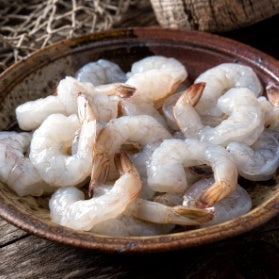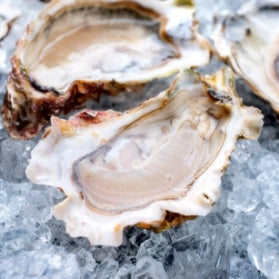Your Cart is Empty
FREE SHIPPING ON ALL ORDERS OVER $125!
FREE SHIPPING ON ALL ORDERS OVER $125!
FREE SHIPPING ON ALL ORDERS OVER $125!
TL;DR: Prioritize sustainability and quality commitments when selecting salmon, looking for sources that offer responsibly harvested seafood that is free from antibiotics.
Salmon is a staple in many diets around the world. It’s prized not only for its deep flavor and versatility in the kitchen but also for its rich nutritional profile and health benefits. However, there is still a lot of misinformation out there about how salmon is sourced and harvested.
When you arrive at your local seafood counter, you’re likely presented with two options: farm-raised or wild-caught. And you might be wondering, what’s the difference?
Today, we take a deep dive into farm-raised vs. wild-caught salmon to explore their nutritional benefits, taste, overall quality, and the environmental implications of how they are sourced.

First thing first, as we’ve talked about before, both wild-caught and farm-raised salmon stand out as superior choices in terms of quality, sustainability, and taste.
So, when it comes to the wild caught vs farm raised salmon debate, neither type is inherently better than the other. Rather, both can be premium quality, sustainable, and delicious.
When caught and raised responsibly, wild and farmed salmon complement each other in preserving a healthy ocean, ensuring seafood availability for future generations.
Farm-raised salmon are a staple of aquaculture, which is simply the technical word for the process of farming seafood. These are salmon that are grown and raised in controlled aquatic environments, as opposed to wild salmon which are caught in their natural, uncontrolled habitats.
Think of aquaculture similar to how modern farms raise chicken, pork, and beef. The process involves growing salmon from juvenile stages to maturity in systems that mimic their natural ecosystem, often within large nets or pens situated in oceans. Salmon farming aims to replicate the wild conditions salmon naturally grow.
The World Wildlife Fund salmon aquaculture is the fastest-growing food production system in the world thanks to the increased demand for this fish and the rapidly improving capabilities of modern farms.
It is important to note that just like farm-raised chicken, pork, and beef – there are salmon farms with good practices and bad practices, which is why consumers must search out products with clearly stated quality and sustainability commitments.
Salmon that is farm-raised vs wild-caught fish can both be sustainable. However, there are more obvious environmental benefits to choosing farm-raised salmon in this regard.
Overfishing is a primary factor in the decline of ocean wildlife populations. The excessive harvesting of fish ultimately disrupts marine ecosystems and compromises the stability of food chains. Fish farming offers a viable solution to relieve the strain on overexploited wild fisheries.
The National Oceanic and Atmospheric Administration (NOAA) explains that wild caught Atlantic Salmon is prohibited in U.S. seafood markets due to overfishing. As a result, wild caught Pacific salmon accounts for the vast majority of wild salmon in the U.S., which is not plentiful enough to sustainably feed the demand. Farmed salmon is one way to help meet the growing demand for seafood and protect the remaining wild populations.
Similar to many other protein sources,a salmon’s diet plays a crucial role in determining their flavor and texture. Farmed salmon are often given a specially customized diet that is high in oils and healthy fats, and typically comprised of a mix of plant and marine ingredients.
This diet not only enriches them with higher levels of Omega-3 fatty acids but also imparts a luxurious, buttery texture that is highly prized by culinary experts around the world.
Finally, it’s important to note that nutritionally, farmed and wild salmon are very similar. Both options stand out as excellent sources of Omega-3 fatty acids and are abundant in Vitamin D, with farmed salmon having slightly higher levels of Omega 3s due to its higher fat content. These Omega-3 fatty acids are proven to have significant health benefits, including reducing inflammation, lowering cholesterol levels, and decreasing the risk of cardiovascular diseases.
When shopping for salmon, it's essential to choose farm-raised options that prioritize health and sustainability. Opt for salmon that is clearly labeled as free from antibiotics, chemicals, growth hormones, and artificial additives. Look for labels like "antibiotic-free" as a reliable indicator of quality. This not only ensures a safer and healthier product but also supports farming practices that are more environmentally responsible.
Additionally, when you see “color added” on farmed salmon packaging, it refers to astaxanthin, an antioxidant and naturally occurring pigment (carotenoid) that is incorporated into the diet of farmed salmon. Astaxanthin is essential for proper nourishment, immune health, and it gives salmon their signature color and nutritional benefits, replicating what wild salmon eat in their natural habitats.
This practice not only enhances the flavor and texture of the salmon but also contributes to its nutritional value.

Wild salmon are caught in their natural habitats, as opposed to being raised in aquaculture settings. They are sourced directly from the oceans, rivers, and lakes where they have lived freely.
However, wild salmon are becoming increasingly difficult to find due to their declining population, which is a result of a variety of factors including climate change, habitat destruction, regulations and conservation efforts, pollution, and cases of overfishing.
Wild salmon are also increasingly expensive to purchase, due to their limited availability and limited fishing season, which usually leads to a short but steep demand surge. This is a big reason why farm-raised Atlantic salmon has become a prominent complementing option.
Wild salmon can be a sustainable option when sourced from well-managed fisheries that adhere to strict regulations designed to maintain healthy populations. These regulations often include limits on the number of fish that can be caught, restrictions on the types of gear used, and careful monitoring of salmon runs to ensure the long-term health of the species.
Practicing sustainable fishing practices is also a major part of this. Wild salmon are typically caught using methods like gillnetting, seining, and trolling, which can be designed to minimize environmental impact:
These methods, when regulated and managed carefully, can be part of sustainable fishing practices that help maintain the balance of marine ecosystems.
When it comes to the taste of wild-caught salmon vs farm raised, the experts at Food Network explain that wild salmon is typically leaner with a bolder flavor. Wild salmon also tend to have a firmer texture due to their active migratory lifestyle, often swimming upstream, which burns calories and contributes to their leanness. Wild salmon may cook faster due to a lower fat content.
As we said before, despite these differences in taste and texture, wild salmon share a similar nutritional profile with their farmed counterparts. Wild salmon do have a slightly lower level of Omega 3 fatty acids due to their lower fat level. The nutrient levels can vary slightly depending on the specific diet and migration patterns of the wild salmon, but overall, they provide comparable health benefits.

Choosing between farmed and wild salmon ultimately comes down to personal preference, overall quality commitments, and environmental concerns. Both types are nutritious options that can support both personal health and the health of our oceans.
When it comes to farm-raised salmon vs wild-caught salmon, sustainability is key. Always look for seafood from sources that employ responsible fishing and farming practices, this way you can do your part while enjoying a delicious meal.
At North Coast Seafoods, we proudly offer both farm-raised Norwegian Salmon and wild Alaska Salmon that contain NO Chemicals, NO Antibiotics, NO Preservatives, and NO ArtificialAdditives. Enjoy only the best seafood delivered directly to your door from North Coast Seafoods.
Looking for wholesale seafood for your restaurant or business? Shoot us an email or fill out our Contact Form.
Comments will be approved before showing up.



Sign up to receive the best seafood recipes, first access to new products, exclusive discounts and more!